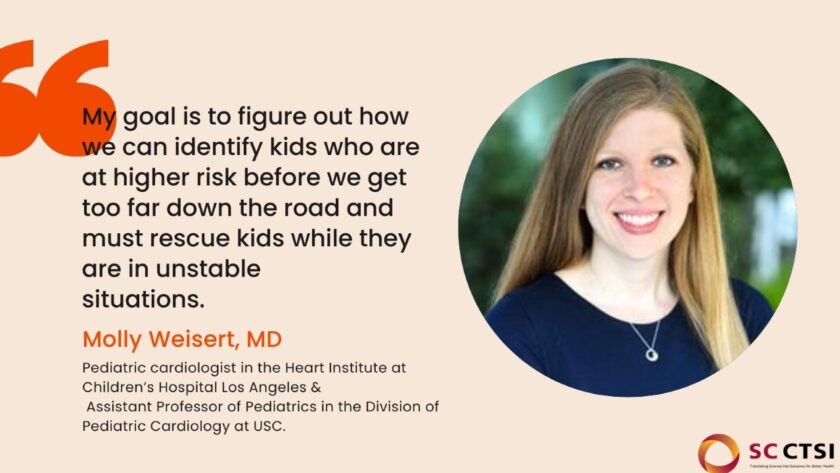SC CTSI-linked biostatistician saves research project about risk factors in surgeries for congenital heart disease
“Ramon saved my bacon at a critical point in this project” says Molly Weisert, MD, a pediatric cardiologist at @ChildrensLA. Read more about how a SC CTSI-linked biostatistician saved a research project about risk factors in surgeries for congenital heart disease.

The most common congenital heart defect requires that babies undergo one surgery shortly after birth and two subsequent ones around the age of two. These children are born with a heart with only one ventricle large enough or strong enough to pump effectively. Advances in surgical techniques and care have allowed more children to survive the three open-heart surgeries required to treat single ventricle congenital heart disease (SV-CHD).
Clinicians increasingly recognize that the three-stage surgical process might not be the best option for all. Some children face a significantly higher risk of death or require a heart transplant later despite the three-stage surgeries.
But which children are most in danger?
A September 2022 retrospective study in The Journal of Heart and Lung Transplantation shows that some combination of four conditions significantly raise the risk of death or a required transplant later in life among 175 surgical patients with SV-CHD. It is the first study to account for all four risk variables in surgical outcomes.
“We found that each warning sign alone is not a setup for a poor outcome,” said lead author Molly Weisert, MD, a pediatric cardiologist in the Heart Institute at Children’s Hospital Los Angeles and an Assistant Professor of Pediatrics in the Division of Pediatric Cardiology at USC. “But if you start seeing a combination of these factors, you may have to start having a different conversation.”
The four risk variables are perinatal lactic acidosis, single right ventricular (RV) morphology, moderate or severe atrioventricular valve regurgitation (AVVR) identified before the second surgery, and moderate ventricular dysfunction, also identified before the second surgery.
But Weisert’s study nearly foundered on the road to publication. Statistical reviewers said per paper included too many risk variables for the number of events in the study.
Weisert was discouraged.
“There have been multiple previous studies looking at each risk factor in isolation. But my goal as a heart failure and transplant specialist is to figure out how we can identify kids who are at higher risk before we get too far down the road and must rescue kids while they are in unstable situations. What this study tells us is that when you start seeing multiple risk factors together, then you need to have that talk with the parents.”
The statistician collaborating on the Weisert project left for another job. That’s when Ramon Durazo-Arvizu, Ph.D., stepped in.
“Ramon saved my bacon at a critical point in this project,” she said.
Durazo-Arvizu is the faculty director of the Biostatistics and Data Analysis Core of The Saban Research Institute at Children’s Hospital Los Angeles (CHLA) and professor of research pediatrics at the USC Keck School of Medicine. He promotes research quality, mentorship, and training at CHLA and with colleagues and students at the Keck School and the Southern California Clinical and Translational Science Institute (SC CTSI).
“I couldn’t have finished this project without him,” said Weisert. “Ramon asked me more questions than my initial statistician did, so he could better understand the clinical implications of what I was looking into. I realized that I needed somebody willing to ask those questions, invest in the project, and not just say, ‘I'll do what you tell me to do.’”
“We can be more helpful to an investigator if we can gain more in-depth background information about a project, said Durazo-Arvizu. “It’s important for investigators to spend time sharing that subject knowledge with the statistician. Knowing more about how you reached your research question helps me be more useful.”
The result of this collaboration is that Weisert and her team could rescue the project.
“Ramon helped me respond to the reviewer comments and rewrite the statistics section in a way that the reviewers accepted,” said Weisert. “He didn’t change the model, and we still included all four variables, and that was crucial.”
Durazo-Arvizu prefers, though, that investigators reach out to him early in their projects.
“When investigators come with a research question, we can help them formalize it,” said Durazo-Arvizu. “It’s best if investigators come to us before the study is designed. That way, we can put the research question in a statistical framework. We discuss which data, variables or information they may need to answer their question.”
The good news is that Durazo-Arvizu’s and his team of biostatisticians are available to aid investigator’s projects. “We have an important role, and we are open for open for business, as they say.”
For more information about Biostatistics, Epidemiology and Research Design services available at USC and CHLA through the SC CTSI, please click here.



